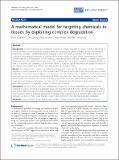A mathematical model for targeting chemicals to tissues by exploiting complex degradation
Author(s)
Gardiner, Bruce S.; Zhang, Lihai; Smith, David W.; Pivonka, Peter; Grodzinsky, Alan J.
Download1745-6150-6-46.pdf (442.8Kb)
PUBLISHER_CC
Publisher with Creative Commons License
Creative Commons Attribution
Terms of use
Metadata
Show full item recordAbstract
Background In many biological and therapeutic contexts, it is highly desirable to target a chemical specifically to a particular tissue where it exerts its biological effect. In this paper, we present a simple, generic, mathematical model that elucidates a general method for targeting a chemical to particular tissues. The model consists of coupled reaction-diffusion equations to describe the evolution within the tissue of the concentrations of three chemical species: a (concentration of free chemical), b (binding protein) and their complex, c (chemical bound to binding protein). We assume that all species are free to diffuse, and that a and b undergo a reversible reaction to form c. In addition, the complex, c, can be broken down by a process (e.g. an enzyme in the tissue) that results in the release of the chemical, a, which is then free to exert its biological action. Results For simplicity, we consider a one-dimensional geometry. In the special case where the rate of complex formation is small (compared to the diffusion timescale of the species within the tissue) the system can be solved analytically. This analytic solution allows us to show how the concentration of free chemical, a, in the tissue can be increased over the concentration of free chemical at the tissue boundary. We show that, under certain conditions, the maximum concentration of a can occur at the centre of the tissue, and give an upper bound on this maximum level. Numerical simulations are then used to determine how the behaviour of the system changes when the assumption of negligible complex formation rate is relaxed. Conclusions We have shown, using our mathematical model, how complex degradation can potentially be exploited to target a chemical to a particular tissue, and how the level of the active chemical depends on factors such as the diffusion coefficients and degradation/production rates of each species. The biological significance of these results in terms of potential applications in cartilage tissue engineering and chemotherapy is discussed. In particular, we believe these results may be of use in determining the most promising prodrug candidates.
Date issued
2011-09Department
Massachusetts Institute of Technology. Center for Biomedical Engineering; Massachusetts Institute of Technology. Department of Electrical Engineering and Computer Science; Massachusetts Institute of Technology. Department of Mechanical EngineeringJournal
Biology Direct
Publisher
BioMed Central Ltd
Citation
Gardiner, Bruce S. et al. “A mathematical model for targeting chemicals to tissues by exploiting complex degradation.” Biology Direct 6 (2011): 46.
Version: Final published version
ISSN
1745-6150